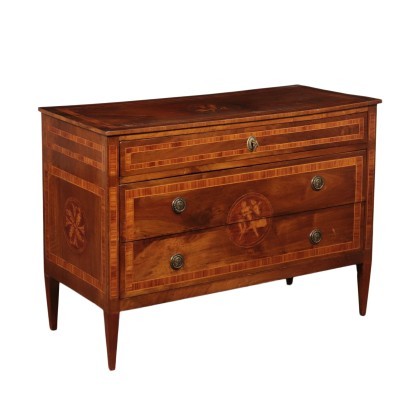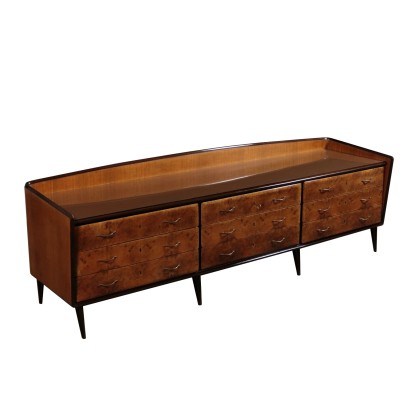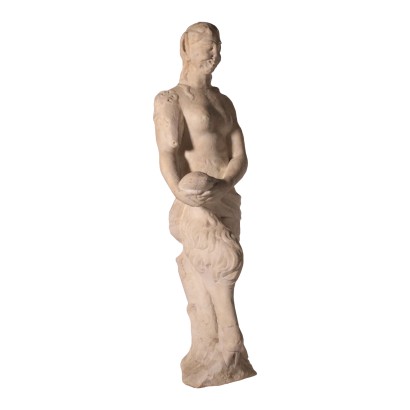Inlaid Chest of Drawers, Walnut,Italy 18th-19th Century
Features
Style: Neo-Classical (1765-1790)
Age: 19th Century / 1801 - 1900 , 18th Century / 1701 - 1800
Origin: Italy
Main essence: Silver Fir , Maple , Brazilian Rosewood , Walnut
Description
Inlaid chest of drwawers supported by four truncated pyramidal feet; two frontal drawers surmounted by a third drawer in the band underneath the top. Walnut with marple and brazilian rosewood inlays. Along the sides, inside two reserves, there are two well preserved rose window inlaid with leafy patterns; the two rose windows in the middle of the frontale side and the top surface that represent two couples of people had been painted again due to a restauration works. The inside of the drawers and the back are made with fir tree.
Product Condition:
Fair condition. Wear consistent with age and use.
Dimensions (cm):
Height: 85
Width: 118
Depth: 53,5
Additional Information
Style: Neo-Classical (1765-1790)
This historical period includes a first phase that can be properly defined as the Louis XVI style.
nOnly at a later time, with the maturation of archaeological fashions, was a new vision of furnishing civilization formulated and codified, now fully attributable to the Neoclassical Style.
In fact, both trends coexisted in unison until the last years of the eighteenth century.
nIn the field of cabinet making, the Directoire, Retour d'Egypte, Consular and Empire styles also fall within the neoclassical era.
nFind out more about Neoclassicism with the insights from our blog...
n Age:
19th Century / 1801 - 1900
19th Century / 1801 - 1900
18th Century / 1701 - 1800
18th Century / 1701 - 1800 Main essence:
Silver Fir
Soft coniferous wood, used for rustic furniture or to build the chest, that is the structure, of furniture then veneered in more precious woods. It has been used since ancient times, its most valuable use is, in the Spruce variant, in the inlays of French antique furniture of the '700 . The spruce, more typical of northern Europe, in Italy grows mainly in the Eastern Alps at altitudes above 1300 m. The noblest use of this essence was in the construction of violins, guitars and cellos: Stradivari himself produced his famous violins with this wood.
Maple
Hard, light wood used for inlays. It grows mainly in Austria, but it is widespread throughout the northern hemisphere, from Japan to North America, passing through China and Europe. It is one of the lightest woods ever, tending to white, it is similar to lime or birch wood. The briar is used in the production of ancient secretaires .
Brazilian Rosewood
It is a hard, light blond wood, but with strong red and pinkish veins, which is obtained from tropical trees similar to rosewood. Its veins are reminiscent of striped tulips, which is why it is called tulipwood in English-speaking areas. It is used for inlays, often combined with bois de violette. In the 1700s and 1800s it was highly appreciated and used in France and England for precious veneers. It gives off scent for decades if not centuries after curing.
Walnut
Walnut wood comes from the plant whose botanical name is juglans regia , probably originally from the East but very common in Europe. Light or dark brown in color, it is a hard wood with a beautiful grain, widely used in antique furniture. It was the main essence in Italy throughout the Renaissance and later had a good diffusion in Europe, especially in England, until the advent of mahogany. It was used for solid wood furniture and sometimes carvings and inlays, its only big limitation is that it suffers a lot from woodworm. In France it was widely used more than anything else in the provinces. In the second half of the eighteenth century its use decreased significantly because mahogany and other exotic woods were preferred. 































